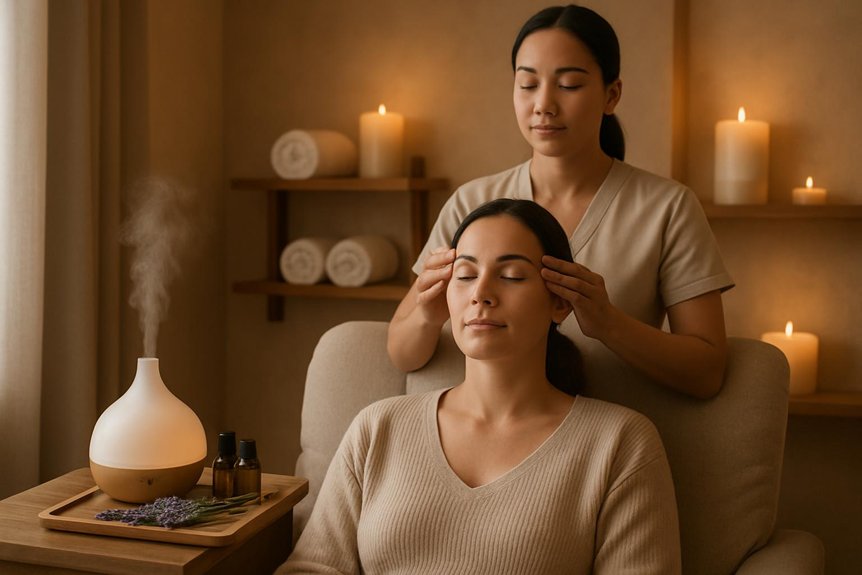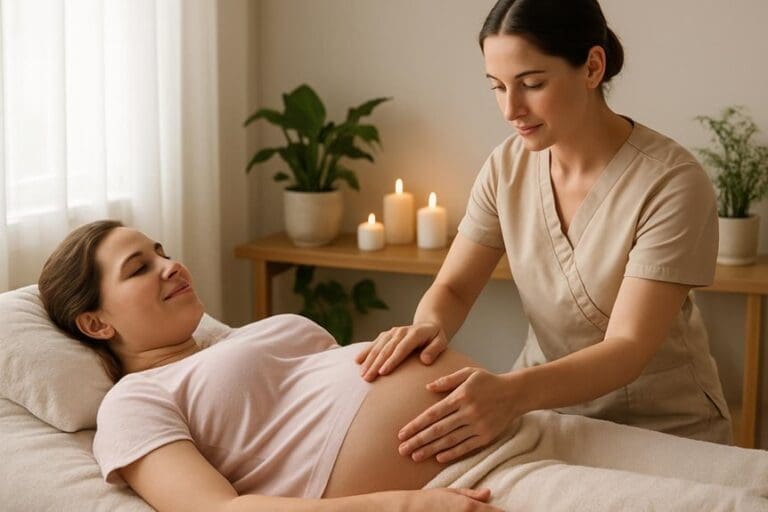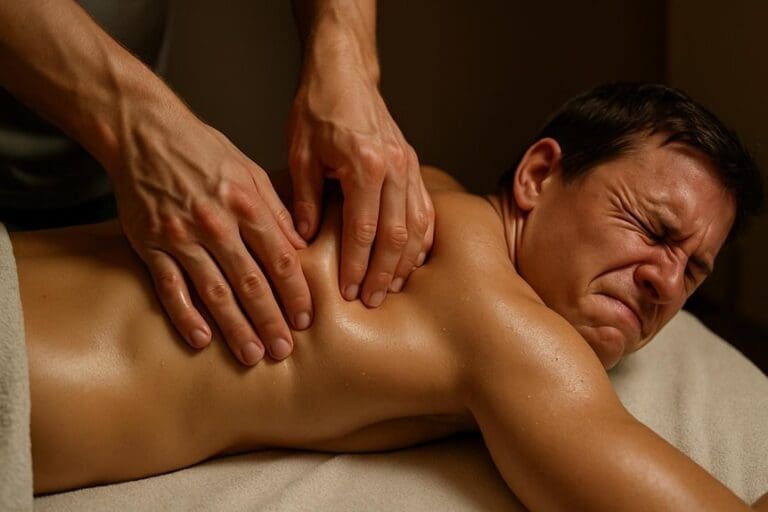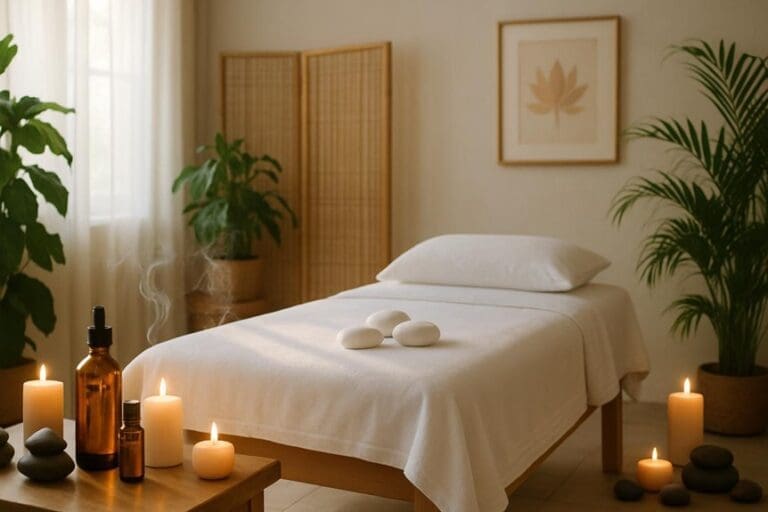Massage and aromatherapy can support cluster headache care between attacks. Gentle cervical and suboccipital techniques may reduce nociceptive input to the trigeminocervical complex and promote parasympathetic tone. Low‑dose essential oils (1–2%) such as peppermint, lavender, or frankincense via inhalation or topical use may modulate trigeminal pathways; patch‑test first. Avoid vigorous work and facial oils during active bouts. These methods are adjuncts, not substitutes, for oxygen and triptans. Guidance on timing, safety, and specific techniques follows.
Understanding Cluster Headaches: Key Symptoms and Triggers
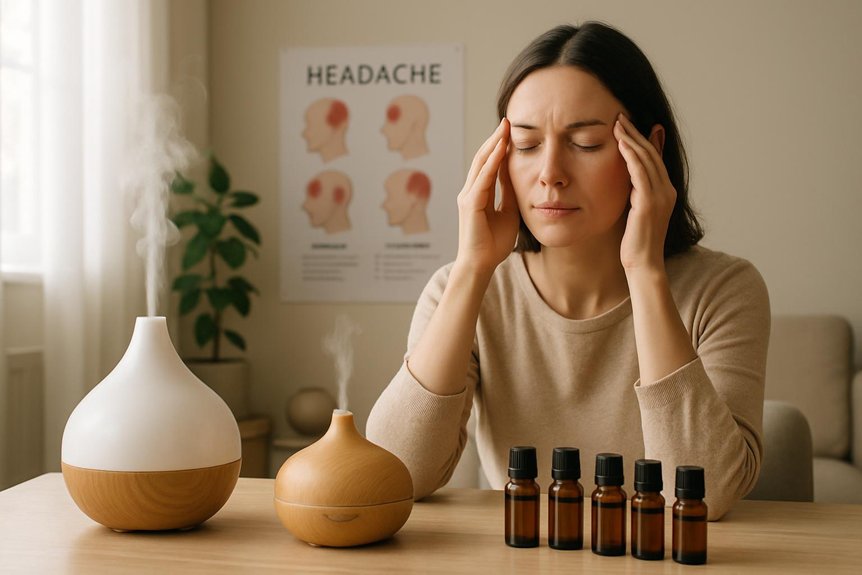
Why do cluster headaches present with such abrupt, severe pain? Evidence indicates activation of the trigeminal–autonomic reflex with hypothalamic involvement, producing sudden unilateral orbital or temporal pain lasting 15–180 minutes.
Autonomic signs—lacrimation, conjunctival injection, nasal congestion or rhinorrhoea, eyelid oedema, facial flushing, and partial Horner’s syndrome—often accompany the attack. Restlessness and a circadian–circannual pattern are typical, with bouts clustered over weeks.
Common triggers include alcohol during active periods, histamine or nitroglycerin exposure, abrupt changes in sleep, high altitude, and strong odours. Some report thermal shifts or intense exertion as precipitating factors.
From Spa & Massage’s perspective, clear recognition of prodromal cues, strict sleep regularity, hydration, and avoidance of known triggers help clients navigate daily life and plan calming, low-stimulus routines between attacks. Incorporating aromatherapy massage techniques may promote relaxation and emotional well-being, supporting clients in managing stress throughout and between headache cycles.
How Massage May Influence Cluster Headache Pathways
Building on the trigeminal–autonomic mechanism and hypothalamic rhythms described above, manual therapies may modulate nociceptive and autonomic pathways relevant to cluster headache. Evidence suggests myofascial release and cervical mobilisations can reduce pericranial muscle hypertonicity, dampening afferent input to the trigeminocervical complex.
Gentle pressure along suboccipital tissues may influence C1–C3 convergence, potentially lowering central sensitisation. Parasympathetic upregulation through slow, sustained strokes can shift heart-rate variability toward vagal dominance, countering sympathetic arousal often present peri-attack.
At Spa & Massage, clinicians tailor session intensity, prioritising non-provocative techniques between bouts and avoiding facial compression during active attacks. Targeted work to upper trapezius, SCM, temporalis, and masseter is applied cautiously.
Clients are guided in diaphragmatic breathing and paced exhalation to reinforce autonomic recalibration and reduce trigger susceptibility.
Aromatherapy Essentials: Oils and Blends Our Therapists Recommend
Spa & Massage therapists prioritise targeted essential oils with emerging evidence for headache modulation, such as peppermint (menthol-mediated trigeminal cooling), lavender (anxiolytic and sedative effects), and frankincense (anti-inflammatory potential).
In our clinics, blends are prepared at low dermal concentrations (typically 1–2% in hypoallergenic carriers) with patch testing, avoidance near eyes, and contraindication checks (e.g., pregnancy, asthma, medication interactions).
Clients are instructed on safe use: brief inhalation or temple/occipital application with gentle massage, limited frequency, and cessation if irritation or symptom escalation occurs.
Targeted Essential Oils
How can aromatherapy be optimised for cluster headache management? Spa & Massage therapists prioritise essential oils with plausible neurovascular and trigeminal-modulating actions.
Peppermint (menthol) is applied in low dilution to temples and suboccipital margins to enhance cutaneous vasodilation and counter-irritation.
Lavender (linalool, linalyl acetate) supports autonomic settling and sleep continuity between attacks.
Frankincense may attenuate nociceptive signalling through terpenoid-mediated anti-inflammatory effects.
Roman chamomile offers gentle muscle relaxation across the scalp and neck.
For clients sensitive to olfactory triggers, therapists use minimal diffusion and prefer targeted dermal application.
Carrier oils with rapid absorption—such as fractionated coconut or grapeseed—are selected to avoid residue and fragrance buildup.
Oils are introduced individually to observe response during quiet, dimly lit sessions, aligning with clients’ intimacy needs and clinical prudence.
Safe Blending Tips
From targeted essential oils, attention turns to formulation parameters that keep aromatherapy safe and therapeutically coherent for cluster headache.
Spa & Massage therapists advise conservative dosing: total essential oil concentration 1–2% for facial and neck application, up to 3% for shoulders. High-quality carrier oils (fractionated coconut, grapeseed) ensure rapid spread without heaviness. Sensitising oils and high-menthol blends are kept below 0.5% near eyes to avoid lacrimation.
Patch testing precedes use; phototoxic citrus oils are excluded before daylight exposure. Diffusion is limited to 15–20 minutes, with adequate ventilation. Topical placement avoids the orbital rim and mucosa.
During active bouts, single-note formulas (e.g., lavender or frankincense) reduce olfactory load. Documentation of triggers, timing, and response guides adjustments. In clinic, therapists blend fresh, batch-tracked oils for reproducibility and comfort.
Safe Timing: When to Seek Massage During a Cluster Cycle
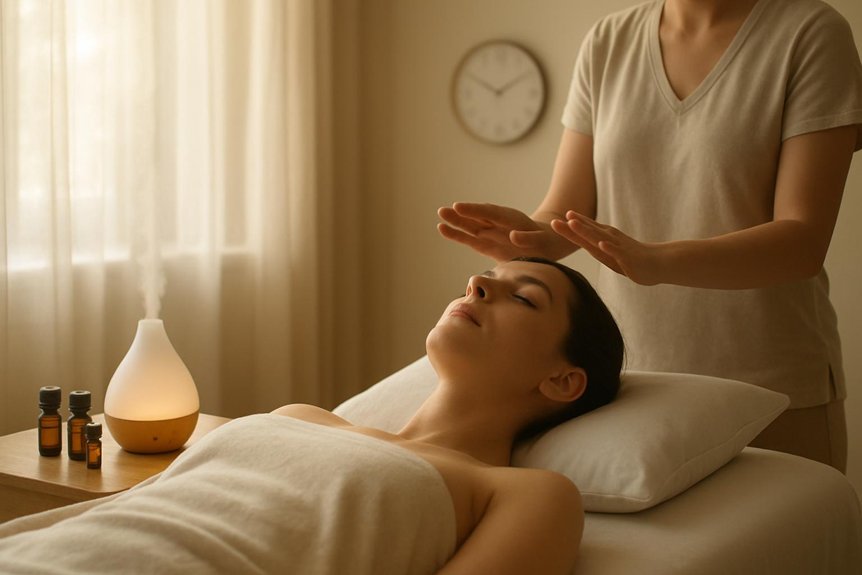
When is massage appropriate within a cluster headache cycle? Evidence suggests timing is critical.
During an acute attack, touch can exacerbate allodynia and autonomic distress; Spa & Massage advises avoiding hands-on work until the peak has passed and pain is clearly declining.
Between attacks within an active bout, gentle, non-provocative sessions can downregulate sympathetic arousal and relieve pericranial muscle tension that amplifies triggerability.
In our clinics, therapists schedule shorter appointments early in remission windows, monitor for prodromal cues, and maintain calm, low-stimulus rooms to minimise trigeminal activation.
Clients in high-frequency clusters are encouraged to coordinate timing with preventive medication schedules and to postpone sessions after alcohol or sleep loss.
Red flags—new neurologic deficits, sudden “worst-ever” pain, fever, or visual changes—warrant urgent medical assessment before massage.
Techniques We Use: Neck, Shoulder, and Scalp Focus for Relief
Once timing is optimised between attacks, Spa & Massage therapists apply targeted manual techniques to the cervical, shoulder-girdle, and scalp tissues implicated in trigeminal–cervical convergence.
Assessment guides graded pressure along suboccipital muscles, upper trapezius, levator scapulae, and sternocleidomastoid to reduce myofascial trigger activity that can refer peri‑orbital pain. Slow, sustained ischemic compression and longitudinal myofascial release are combined with gentle lateral glides at C2–C3 to ease facet irritation without provoking symptoms.
On the scalp, therapists use small-amplitude fascial lifts along temporalis, frontalis, and pericranial aponeurosis, avoiding the symptomatic side during residual allodynia. Precise petrissage around the clavicular attachments restores shoulder-girdle tone and breathing comfort.
In our London clinics, neutral, hypoallergenic oils support controlled glide; therapists monitor autonomic signs and stop if tearing, nasal congestion, or lacrimation escalates.
Calming the Nervous System: Breathwork and At‑Home Self‑Care
Although touch-based interventions target musculoskeletal contributors, autonomic down‑regulation is equally critical for cluster headache management.
Evidence supports parasympathetic activation via slow diaphragmatic breathing (4–6 breaths/min), elongated exhalation, and brief breath holds to reduce hypothalamic‑autonomic arousal linked with cluster attacks. Spa & Massage therapists coach clients in a simple cadence: inhale 4 seconds, hold 2, exhale 6–8, repeat for 5 minutes, 2–3 times daily, and at prodrome.
At home, clients are advised to pair breathwork with low‑stimulus rituals: dim light, cool room, cervical neutral posture, and gentle suboccipital release using a towel roll.
In our clinics, discreet aromatherapy—lavender or chamomile at 1–2% dilution—may complement breathing, avoiding trigeminal irritants. Hydration, steady caffeine timing, and consistent sleep‑wake anchors further stabilise autonomic tone.
When to See Your GP or A&E: Red Flags and Medical Coordination
Spa & Massage advises clients with cluster headache to recognise red flags requiring urgent care, including sudden “worst-ever” headache, new neurological deficits (weakness, confusion, speech or visual loss), fever with neck stiffness, head trauma, or onset after age 50.
For non-emergent changes—such as increased attack frequency, inadequate relief from current medication, or new comorbid symptoms—contacting a GP for evaluation and optimisation of preventive and abortive therapy is recommended.
With consent, our therapists coordinate with the client’s GP or specialist by sharing observations on triggers, attack patterns, and treatment responses to ensure massage and aromatherapy are integrated safely alongside medical care.
Urgent Danger Signs
When should urgent medical care supersede self-management of cluster-like pain? Immediate evaluation is warranted if “the worst headache of life” occurs abruptly, pain is maximal within seconds (thunderclap), or neurological deficits appear: facial droop, limb weakness, dysarthria, confusion, diplopia, seizures, or new neck stiffness with fever.
Red, painful eye with vision loss, unequal pupils, or persistent vomiting also signal danger.
New-onset headache after head trauma, during pregnancy/postpartum, or in adults over 50 with systemic symptoms necessitates urgent assessment.
Sudden change in a known pattern—longer duration, atypical side, continuous pain between attacks, or reduced responsiveness to usual therapy—should prompt escalation.
At Spa & Massage, therapists pause sessions and advise A&E attendance when red flags emerge, coordinating calmly and documenting observations to support clinicians’ rapid triage.
When to Call GP
How should a person with suspected cluster headache navigate GP versus A&E?
If the headache matches a typical cluster pattern—unilateral orbital pain with ipsilateral tearing, nasal congestion, ptosis, or restlessness—contact the GP urgently (same-day appointment). GPs can confirm diagnosis, initiate acute therapy (high-flow oxygen, subcutaneous or intranasal triptan), and arrange neurology referral.
Call A&E or 999 for red flags: “first or worst” thunderclap onset, persistent neurological deficit, fever with meningism, new seizure, head trauma, sudden vision loss, or new severe headache in pregnancy or immunosuppression.
From Spa & Massage’s perspective, coordinated care matters. Clients often ask when bodywork is appropriate; therapists advise GP review before massage during an active, undiagnosed bout.
With a confirmed plan, non-triggering relaxation strategies can be scheduled between attacks.
Coordinating With Therapists
With red flags and urgent pathways defined, coordination between medical care and manual therapy should follow a structured protocol.
At Spa & Massage, therapists document onset, frequency, autonomic signs (lacrimation, nasal congestion), and triggers, then align sessions with the GP or neurologist’s plan.
Any first or worst headache, sudden change in pattern, new neurologic deficit, fever, neck stiffness, head trauma, or vision loss prompts immediate A&E referral and session cessation.
Between attacks, gentle cervical soft-tissue work, suboccipital release, and paced breathing are scheduled away from predicted cluster periods when possible.
Aromatherapy is adjunctive only; in our clinics, non-irritant oils are used sparingly, avoiding facial application.
Therapists confirm medication timing (e.g., triptans, verapamil) to prevent interactions, monitor blood pressure when indicated, and provide clear escalation pathways back to the GP.
Building a Personalised Plan at Spa & Massage London Clinics
A personalised plan for cluster headache support at Spa & Massage begins with a structured consultation to identify trigger patterns, pain distribution, autonomic features, and comorbidities. This is followed by a tailored protocol combining evidence-informed massage and aromatherapy modalities.
Assessment includes cervical myofascial tension, temporomandibular loading, sleep quality, alcohol sensitivity, and medication use.
Frequency is typically 1–2 sessions weekly during active bouts, tapering in remission.
Therapists apply gentle suboccipital release, scalene and sternocleidomastoid decompression, and thoracic outlet mobilisation to modulate nociceptive input without provoking attacks.
In our clinics, aromatherapy blends are conservative: peppermint or lavender in low dilutions, patch-tested, with diffusion avoided if odours trigger symptoms.
Self-care is prescribed: heat to upper traps, diaphragmatic breathing, neck mobility drills, hydration, and trigger diaries.
Coordination with medical care and red-flag screening are standard.
Conclusion
In brief, massage and aromatherapy may complement medical care for cluster headache by reducing myofascial tension, modulating autonomic arousal, and improving sleep quality. When delivered by trained therapists with clear safety screening and timing outside acute peaks, these modalities can be integrated like a calibrated adjunct, not a cure. Clients benefit from targeted cervical–scalp techniques, judicious essential oils, and breathwork, with red‑flag vigilance and GP coordination. Consistency and personalised plans support symptom management, functional recovery, and informed self‑care.
